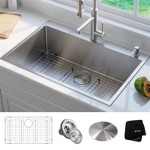One Bowl Undermount Kitchen Sinks: A Comprehensive Guide
One-bowl undermount kitchen sinks have become increasingly popular in modern kitchen design. Their sleek, minimalist appearance and practical functionality make them a desirable choice for homeowners. This article will explore the various aspects of one-bowl undermount sinks, covering materials, sizes, installation, maintenance, and advantages and disadvantages.
Materials
One-bowl undermount sinks are manufactured from a variety of materials, each offering distinct characteristics regarding durability, aesthetics, and cost. Common materials include:
*Stainless Steel: A popular choice due to its resistance to stains, rust, and heat. Stainless steel sinks are available in various gauges, with lower gauges indicating thicker, more durable steel.
*Cast Iron: Known for its durability and classic appearance. Cast iron sinks are coated with porcelain enamel to protect against chipping and staining. However, they can be heavier and more expensive than stainless steel.
*Composite Granite: Made from a blend of granite particles and resin, these sinks offer excellent resistance to scratches, stains, and heat. They are available in a wide range of colors to complement various countertop materials.
*Fireclay: A type of ceramic fired at extremely high temperatures, resulting in a durable and heat-resistant sink. Fireclay sinks are known for their smooth, glossy finish.
*Copper: A visually striking option that develops a unique patina over time. Copper sinks are naturally antimicrobial and relatively easy to maintain.
Sizes and Configurations
One-bowl undermount sinks are available in a range of sizes to accommodate various kitchen layouts and user needs. Considerations include the overall dimensions of the sink and the depth of the bowl.
*Small Sinks: Typically less than 24 inches wide, these sinks are suitable for smaller kitchens or as a secondary sink in a larger kitchen.
*Medium Sinks: Ranging from 24 to 30 inches wide, these sinks offer a good balance of size and functionality for most kitchens.
*Large Sinks: Over 30 inches wide, these sinks provide ample space for washing large pots and pans, making them ideal for households that frequently cook.
*Bowl Depth: The depth of the bowl impacts its capacity and usability. Deeper bowls can accommodate larger items but may require more bending. Shallower bowls are easier to access but may not be as practical for washing large pots and pans.
Installation
The installation of an undermount sink requires precise measurements and professional expertise. The process typically involves:
*Template Creation: A template of the sink is created to ensure accurate placement and cutting of the countertop.
*Countertop Cutout: The countertop is carefully cut to accommodate the sink, leaving a precise lip for the sink to attach to.
*Sink Attachment: The sink is secured to the underside of the countertop using adhesive and mounting clips.
*Sealing: A silicone sealant is applied around the perimeter of the sink to prevent water leakage and create a seamless transition between the sink and countertop.
Maintenance
Proper maintenance is essential for preserving the appearance and functionality of a one-bowl undermount sink. Regular cleaning can prevent stains, mineral buildup, and other issues.
*Daily Cleaning: Wipe the sink with a soft cloth and mild dish soap after each use. Rinse thoroughly and dry to prevent water spots.
*Stain Removal: For stubborn stains, use a non-abrasive cleaner specifically designed for the sink material. Avoid using harsh chemicals or abrasive scouring pads, which can damage the surface.
*Mineral Buildup Removal: Periodically clean the sink with a solution of vinegar and water to remove mineral deposits and maintain its shine.
Advantages of One-Bowl Undermount Sinks
One-bowl undermount sinks offer several advantages over traditional drop-in sinks:
*Seamless Appearance: The undermount design creates a clean, uninterrupted transition between the countertop and the sink, enhancing the overall aesthetic of the kitchen.
*Easy Cleaning: The absence of a raised rim around the sink makes it easier to wipe crumbs and spills directly into the sink, simplifying cleanup.
*Increased Counter Space: The undermount design maximizes usable counter space, especially beneficial in smaller kitchens.
Disadvantages of One-Bowl Undermount Sinks
While offering many benefits, one-bowl undermount sinks also have some potential drawbacks:
*Cost: Undermount sinks, particularly those made from high-end materials, can be more expensive than traditional drop-in sinks.
*Installation Complexity: The installation process is more complex and requires professional expertise, which can add to the overall cost.
*Limited Configuration Options: While available in various sizes, one-bowl sinks offer fewer configuration options compared to double-bowl sinks, which may be less practical for some users.

30 Undermount Single Bowl Stainless Steel Kitchen Sink Kraus

16 Gauge Undermount Stainless Steel Single Bowl Kitchen Sink

Horow 32 In 16 Gauge Undermount Single Bowl Stainless Steel Kitchen Sink With Bottom Grid Basket Strainer Cutout Template Hr S3219d The Home

Ruvati 33 Inch Undermount 16 Gauge Rounded Corners Large Kitchen Sink Stainless Steel Single Bowl Rvh7433 Usa

Shop Best Undermount Kitchen Sinks The Sink Boutique Free Shipping

Drop In Undermount 31 Granite Kitchen Sink Black Onyx Kraus

Ruvati 30 Inch Workstation Ledge Undermount 16 Gauge Stainless Steel Kitchen Sink Single Bowl Rvh8310 Usa

Karran Undermount 32 25 In X 19 White Quartz Single Bowl Kitchen Sink Qu 812 Wh At Lowes Com

Vellamo Horizon Undermount Extra Large Single Bowl Stainless Steel Kitchen Sink Waste Kit 700mm X 450mm Tap Warehouse

Single Bowl Sinks Undermount Kitchen Sink








